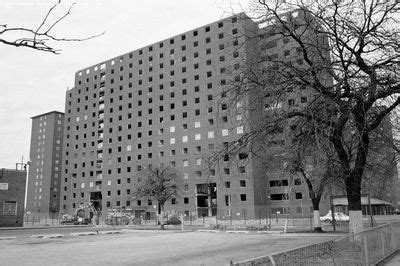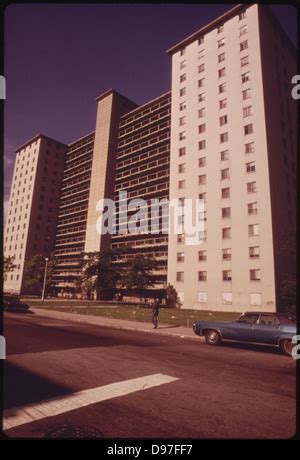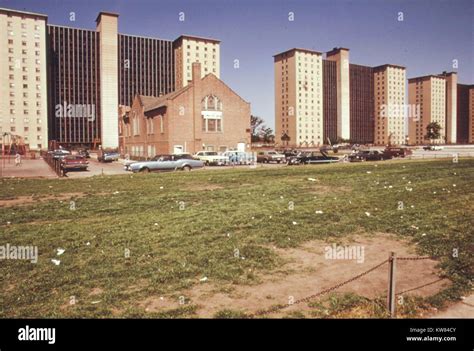The Robert Taylor Homes in Chicago, Illinois, were a monumental example of public housing in the United States, reflecting both the ambitions and the challenges of providing affordable housing to low-income families. Named after Robert Taylor, a prominent African American activist and the first African American to chair the Chicago Housing Authority (CHA), the development was designed to address the severe housing shortages faced by African American communities in the post-World War II era.
Completed in 1962, the Robert Taylor Homes were part of a broader effort by the federal government to construct public housing projects across the United States. The complex, located in the Bronzeville neighborhood of Chicago's South Side, consisted of 28 high-rise buildings, totaling 4,415 units. At the time of its construction, it was one of the largest public housing projects in the world, aimed at providing a dignified and safe living environment for its residents. However, over the years, the Robert Taylor Homes became synonymous with the failures of public housing policy in the United States, plagued by issues of poverty, crime, and poor living conditions.
Key Points
- The Robert Taylor Homes were a significant public housing project in Chicago, reflecting the city's efforts to address housing shortages for low-income African American families.
- Completed in 1962, the complex consisted of 28 high-rise buildings with 4,415 units, making it one of the largest public housing projects in the world at the time.
- Despite its initial ambitions, the Robert Taylor Homes faced numerous challenges, including poverty, crime, and poor living conditions, which ultimately led to its demolition.
- The story of the Robert Taylor Homes serves as a case study for the complexities of public housing policy in the United States, highlighting the need for comprehensive approaches that address social, economic, and environmental factors.
- The demolition of the Robert Taylor Homes and the relocation of its residents marked a shift towards mixed-income housing developments, aiming to create more integrated and sustainable communities.
The Construction and Initial Years of the Robert Taylor Homes

The construction of the Robert Taylor Homes was a response to the urgent need for housing in African American communities in Chicago. The post-war era saw a significant influx of African Americans moving from the rural South to urban centers in the North, seeking better economic opportunities. However, they faced severe discrimination in the housing market, leading to overcrowding and poor living conditions in segregated neighborhoods. The Robert Taylor Homes, with its modern high-rise design and promises of community facilities, was envisioned as a beacon of hope, offering a chance for African American families to live in dignity and safety.
Design and Layout of the Robert Taylor Homes
The design of the Robert Taylor Homes reflected the modernist architectural ideals of the time, emphasizing functionality, efficiency, and community. The high-rise buildings were arranged to maximize green spaces and provide easy access to community facilities, such as schools, healthcare centers, and recreational areas. However, the actual implementation of these designs often fell short of the ideals, with many residents facing issues of isolation, lack of community engagement, and inadequate access to essential services.
| Year | Event | Description |
|---|---|---|
| 1962 | Completion of Construction | The Robert Taylor Homes were completed, marking one of the largest public housing projects in the world at the time. |
| 1970s-1980s | Rise of Social Issues | The project began to experience significant social problems, including high crime rates, poverty, and dilapidated living conditions. |
| 1990s-2000s | Demolition and Redevelopment | The Chicago Housing Authority initiated plans to demolish the Robert Taylor Homes as part of a broader effort to transform public housing in Chicago, replacing high-rise projects with mixed-income developments. |

The Challenges Faced by the Robert Taylor Homes

Despite its initial promises, the Robert Taylor Homes soon became emblematic of the failures of public housing policy in the United States. The project faced numerous challenges, including severe poverty, high crime rates, and poor living conditions. The concentration of poverty and the lack of economic opportunities within the development contributed to a cycle of disadvantage, where residents faced significant barriers to improving their socio-economic status. Additionally, the design of the high-rise buildings, intended to be modern and efficient, often exacerbated the sense of isolation and disconnection among residents, further undermining community cohesion and social support networks.
Policies and Initiatives Aimed at Addressing the Challenges
In response to the mounting challenges, the Chicago Housing Authority and federal agencies implemented various policies and initiatives aimed at addressing the socio-economic issues plaguing the Robert Taylor Homes. These efforts included job training programs, educational initiatives, and community development projects designed to foster a sense of community and provide residents with the tools and resources needed to improve their living conditions. However, these initiatives often faced significant challenges, including inadequate funding, bureaucratic inefficiencies, and the deep-seated nature of the social and economic problems they aimed to address.
What were the primary challenges faced by the Robert Taylor Homes?
+The Robert Taylor Homes faced numerous challenges, including severe poverty, high crime rates, and poor living conditions. The concentration of poverty and the lack of economic opportunities within the development contributed to a cycle of disadvantage.
What initiatives were implemented to address the challenges faced by the Robert Taylor Homes?
+In response to the challenges, various initiatives were implemented, including job training programs, educational initiatives, and community development projects. These efforts aimed to provide residents with the tools and resources needed to improve their living conditions and socio-economic status.
What lessons can be learned from the story of the Robert Taylor Homes?
+The story of the Robert Taylor Homes offers valuable lessons for urban planning and public housing policy. It highlights the importance of considering the social, economic, and environmental context of housing developments and the need for comprehensive, community-driven approaches to creating sustainable and equitable living environments.
In conclusion, the Robert Taylor Homes in Chicago serve as a complex and multifaceted case study for the challenges and opportunities in public housing policy. From its construction as a symbol of hope and opportunity for African American families to its eventual demolition as part of a broader effort to transform public housing, the story of the Robert Taylor Homes underscores the importance of nuanced, community-driven approaches to housing and urban development. As cities around the world grapple with issues of housing affordability, equity, and sustainability, the legacy of the Robert Taylor Homes offers critical insights into the complexities of creating vibrant, inclusive, and thriving urban communities.



